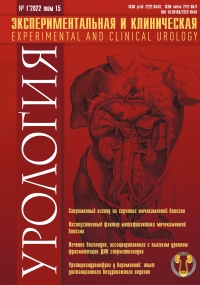Aim. To investigate the effectiveness of structural synthetic (plasticine) biomodeling in percutaneous nephrolithotripsy (PNL) in patients with complex kidney stones.
Materials and methods. The experimental group included 76 patients with complex kidney stones (complete staghorn stones and incomplete staghorn calyx stones, according to the American Urological Association (AUA) classification) over the period of 2012-2015. Computed tomography with intravenous contrast phase injection and subsequent 3D remodeling of the renal pelvicaliceal system was used as the standard method. Before the operation, a surgeon would sculpture a plasticine replica of pelvicaliceal system according to the data obtained from computed tomography. This replica was placed into a sterile package and subsequently transported into the operating room and used as a reference model during the operation in order to simplify intrarenal navigation.
Results. 56 patients (73.6%) were operated in the supine position and 20 (19.4%) – in the prone position. 41 patients (54%) required single-port access, 22 patients (28.9%) – two-port access and 6 patients (7.8%) had three-port access. Five patients (6.5%) needed four-port access and only two patients (2.8%) required five-port access. The mean duration of a surgical intervention was 86±21 min. Repeated nephroscopy was needed for 35 patients (46%). All repeated surgeries were performed 2-3 days a?er the first, in the absence of hyperemia. 12 patients out of 28 (42.8%) with full staghorn kidney stones needed percutaneous nephrolithotomy (nephroscopy) to be repeated. In our study the effectiveness of PNL was 88.2%. ?e results were validated by low-dose computed tomography, which was performed 24 hours a?er every surgery.
Conclusion. The effectiveness of percutaneous nephrolithotomy can be improved by using structural biomodeling. The proposed method allows better understanding of the renal pelvicaliceal system of a given patient and can be used as a reference instrument in the operating room.
Authors declare lack of the possible conflicts of interests






